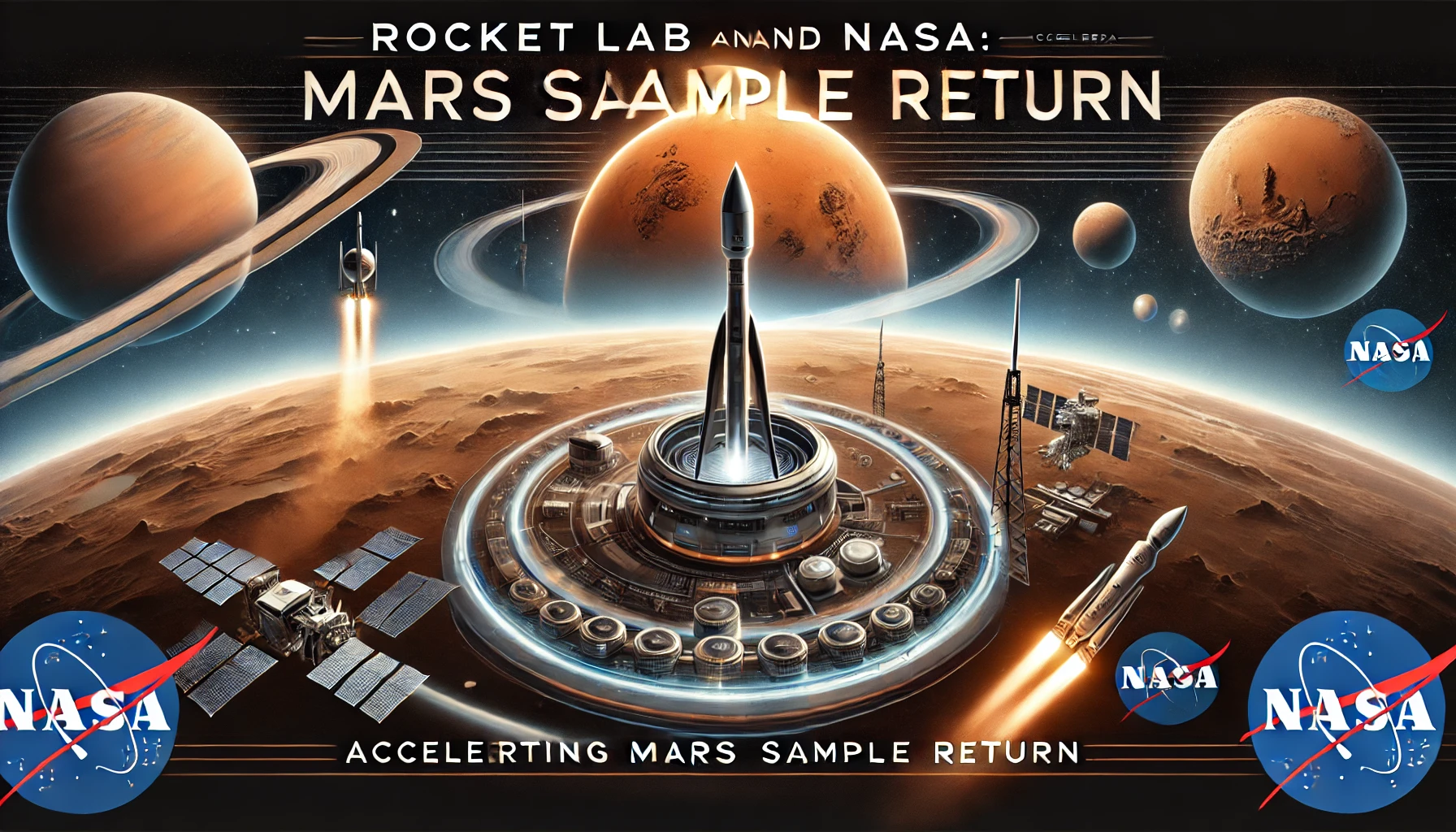Rocket Lab’s Groundbreaking Contribution to NASA’s Mars Sample Return Mission
The dream of bringing Martian samples back to Earth has been alive for decades, and with NASA’s ongoing Mars Sample Return mission, that dream is closer than ever to becoming a reality. NASA recently awarded Rocket Lab a study contract to explore innovative, cost-effective solutions to achieve this ambitious goal. As part of the program, Rocket Lab will play a pivotal role in simplifying and speeding up the Mars Sample Return mission, while keeping costs lower than previously projected.
In this blog, we will dive into the NASA Mars Mission, Rocket Lab’s involvement, the Mars Ascent Vehicle, the technical aspects of the mission, and the future of the Mars Return Mission timeline.
NASA Mars Mission: Aiming to Return Martian Samples to Earth
NASA’s Mars Sample Return mission is an ambitious multi-phase project aimed at collecting samples from Mars’ surface and bringing them back to Earth for analysis. The Perseverance Rover is currently collecting rock samples from an ancient river delta in Jezero Crater. These samples could hold the key to understanding Mars’ geological history and answering the big question: Was there ever life on Mars?
While NASA and the European Space Agency (ESA) initially developed a detailed plan, the mission encountered delays and budgetary concerns. Originally slated for the early 2030s, the Mars Return Mission timeline now stretches to 2040 due to the project’s complexity and rising costs. At the heart of the mission are three spacecraft: a lander, a Mars Ascent Vehicle (MAV), and an orbiter(SpaceNews)(NASA).
However, in light of recent challenges, NASA sought alternative solutions and awarded study contracts to companies like Rocket Lab, hoping to streamline the mission and reduce costs.
Rocket Lab’s Role in Mars Sample Return
Rocket Lab has emerged as a key player in NASA’s Mars Sample Return mission, with a proven track record in cost-effective space exploration. After its successful work on NASA’s CAPSTONE lunar mission, Rocket Lab was awarded a contract to study how it could help deliver Martian samples more efficiently. Rocket Lab’s proposal focuses on using its Neutron Rocket and other proprietary spacecraft technologies to develop a streamlined, end-to-end solution for the mission(SpaceNews).
Rocket Lab’s CEO, Peter Beck, is confident in the company’s ability to meet NASA’s expectations. Beck stated, “We’ve developed an innovative mission concept to make it happen affordably and on an accelerated schedule.” By leveraging Rocket Lab’s experience in launching small satellites and lunar missions, the company aims to achieve a low-cost, rapid Mars Sample Return mission. The study, once completed, will outline how Rocket Lab’s Neutron Rocket could be used to return the samples much earlier than NASA’s projected 2040 timeline, potentially as early as 2033(Business Wire).
How Rocket Lab’s Neutron Rocket Will Help
Rocket Lab’s Neutron Rocket is key to its Mars Sample Return proposal. Designed for heavy payloads, the Neutron Rocket is versatile and capable of conducting complex interplanetary missions. In the proposed mission, Rocket Lab plans to use two Neutron Rocket launches: one to send an orbiter to Mars and the other to deploy the lander and the Mars Ascent Vehicle (MAV)(Business Wire)(Space.com).
Once on Mars, the Perseverance Rover will rendezvous with the lander, transferring the collected samples to the MAV. The MAV will then launch the samples into Martian orbit, where the orbiter will retrieve them for the return journey to Earth. This approach reduces costs by simplifying the number of spacecraft involved, compared to NASA’s original three-vehicle architecture(Space.com).
The Mars Ascent Vehicle: A Critical Component
The Mars Ascent Vehicle (MAV) plays a pivotal role in the Mars Sample Return mission. As the first-ever rocket to launch from the surface of another planet, the MAV must carry the collected samples from Mars’ surface to orbit, where they will be retrieved by an orbiter and sent back to Earth(SpaceNews).
In the original NASA plan, the MAV would be delivered to Mars by a lander, and the samples would be loaded onto it using small helicopters. However, Rocket Lab’s simplified architecture aims to streamline this process by reducing the number of spacecraft and mechanical components required. This will lower the risk of failure while ensuring a faster, more efficient sample retrieval process(Space.com).
Rocket Lab’s approach also leverages its prior experience in satellite launches and interplanetary missions. The company has successfully built and launched small spacecraft for missions like NASA’s CAPSTONE mission to the Moon and the ESCAPADE mission to Mars. Rocket Lab’s experience positions it as an ideal candidate to help NASA achieve a faster and more affordable Mars Sample Return mission(Business Wire).
The Future of the Mars Return Mission Timeline
NASA’s initial timeline for returning samples from Mars has been extended, with estimates now pushing the return date to 2040. However, Rocket Lab’s involvement could drastically reduce this timeline. By targeting a 2028 launch window, Rocket Lab is proposing a solution that could bring samples back to Earth as early as 2033, and potentially even by 2031(Benzinga)(NASA).
The pressure to accelerate the mission is not just about saving time; it’s also about preserving the samples’ integrity. The Perseverance Rover, currently collecting samples, has a limited operational lifespan. A faster return will ensure that the rover remains functional long enough to transfer the samples to the MAV, minimizing the risk of sample degradation(Space.com).
Challenges and Potential Delays
Despite Rocket Lab’s optimism, there are still significant challenges ahead. Returning Martian samples involves numerous technical hurdles, such as ensuring safe re-entry into Earth’s atmosphere and protecting the samples from contamination. Furthermore, the cost of the mission remains a concern. NASA’s initial budget for the Mars Sample Return mission has ballooned from $7 billion to $11 billion, a price tag higher than that of the James Webb Space Telescope(NASA).
Rocket Lab’s proposal aims to reduce these costs by simplifying the mission architecture, but the feasibility of these savings will depend on the outcomes of the ongoing study. The final decision on whether to move forward with Rocket Lab’s proposal will depend on NASA’s evaluation of its cost, schedule, and technical merits(Business Wire).
Rocket Lab’s Innovative Path Forward
The Mars Sample Return mission is a monumental step in planetary science, and Rocket Lab’s involvement represents a promising new approach. By offering a simplified, cost-effective solution, Rocket Lab is positioning itself as a key player in interplanetary exploration. The company’s expertise, combined with NASA’s pioneering efforts, could make it possible to bring Martian samples back to Earth much sooner than previously thought.
As the mission moves forward, the collaboration between NASA and Rocket Lab could redefine how we approach large-scale space missions. Whether it’s the cutting-edge Neutron Rocket, the first-ever Mars Ascent Vehicle, or the relentless work of the Perseverance Rover, the journey to bring Mars samples to Earth is one of the most exciting endeavors in space exploration today.
For more information on NASA’s space missions, visit Regent Studies. You can also stay updated on Rocket Lab’s progress by visiting their official website or checking out the latest updates from SpaceNews.




